Kabuki theatre is a fascinating aspect of traditional Japanese theatre that has been captivating audiences for centuries. This unique form of theatre is known for its elaborate costumes, makeup, and dramatic performances. In this article, we will explore the history and significance of Kabuki theatre.
History of Kabuki
Kabuki theatre originated in the Edo period of Japan (1603-1868) and was developed by a performer named Izumo no Okuni. She was known for her dance performances that featured exaggerated movements and a unique style of singing. Her performances were popular among the common people, and soon other performers began to adopt her style.
Initially, Kabuki theatre was performed by women, but due to the nature of the performances, it was eventually banned by the government in 1629. This led to the emergence of male actors who took over the roles previously played by women. The performances began to focus on male characters, and the art form became more refined.
Over time, Kabuki theatre evolved to include more elaborate costumes, makeup, and dramatic performances. The stories began to include historical events, love stories, and tales of revenge. The performances were accompanied by traditional Japanese music, and the actors were recognized for their unique vocal styles.
Significance of Kabuki
Kabuki theatre holds significant cultural importance in Japan and is considered a national treasure. It represents the rich history and traditions of the country and is a reflection of Japanese society. The performances are a celebration of Japanese art and culture and are an essential part of the country’s heritage.
One of the significant features of Kabuki theatre is its elaborate costumes and makeup. The actors spend hours getting ready for a performance, and the intricate designs are a reflection of the character they are playing. The makeup is designed to exaggerate the facial expressions of the actors and is an essential part of the performance.
Another important aspect of Kabuki theatre is the use of traditional Japanese music. The music is played on traditional instruments, and the melodies are unique to Kabuki performances. The music sets the tone for the performance and adds to the overall experience.
Kabuki theatre is also significant because it represents a unique form of theatre that is different from Western theatre. It is not focused on realism but instead emphasizes the stylized performances and exaggerated movements. It is a form of theatre that is meant to entertain and captivate the audience.
Conclusion
Kabuki theatre is a unique and fascinating aspect of traditional Japanese theatre. Its history and significance are a reflection of Japanese culture and traditions. The elaborate costumes, makeup, and dramatic performances are an essential part of the experience, and the use of traditional Japanese music adds to the overall ambiance.
Kabuki theatre has been captivating audiences for centuries and will continue to do so for generations to come. It is a testament to the enduring power of theatre and its ability to connect people across time and cultures. Kabuki theatre is truly a national treasure and an essential part of Japan’s cultural heritage.







